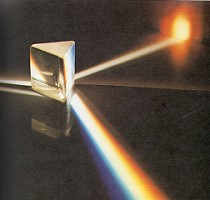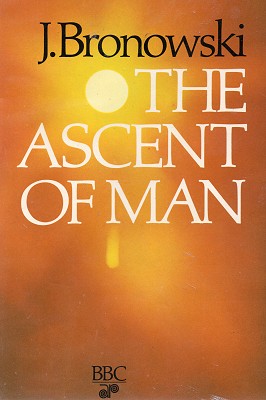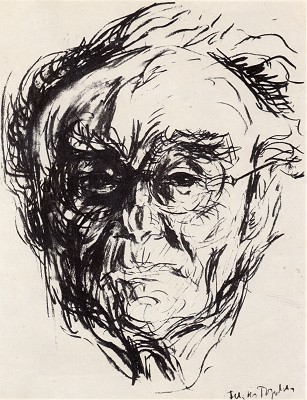
surfresearch.com.au
Jacob Bronowski:
The Ascent of Man, 1973.
 |
surfresearch.com.au
Jacob Bronowski: The Ascent of Man, 1973. |
| Foreword Chapter 1 Lower than the Angels Animal adaptation - The human alternative - Beginning in Africa - Fossil evidence - The gift of foresight - Evolution of the head - The mosaic of man - The cultures of the hunter - Across the ice ages - Transhumance cultures: the Lapps - Imagination in cave art. Chapter 2 The Harvest of the Seasons The pace of cultural evolution - Nomad cultures: the Bakhtiari - Beginnings of agriculture : wheat - Jericho - Earthquake country - Technology in the village - The wheel - Domestication of animals: the horse - War games: Buz Kashi - Settled civilisation. Chapter 3 The Grain in the Stone Coming to the New World - Blood group evidence of migrations - The actions of shaping and splitting - Structure and hierarchy - The city: Machu Picchu - Straight-edge architecture: Paestum - The Roman arch: Segovia - The Gothic adventure: Rheims - Science as architecture -The hidden figure: Michelangelo to Moore - Pleasure in construction - Below the visible. Chapter 4 The Hidden Structure Fire, the transforming element - Extraction of metals: copper - The structure of alloys - Bronze as a work of art - Iron to steel: the Japanese sword- Gold.—The incorruptible - Alchemical theory of man and nature - Paracelsus and the coming of chemistry - Fire and air: Joseph Priestley -Antoine Lavoisier: combination can be quantified - John Dalton's atomic theory. Chapter 5 The Music of the Spheres The language of numbers - The key to harmony: Pythagoras - The right-angled triangle - Euclid and Ptolemy at Alexandria - Rise of Islam - Arabic numbers - The Alhambra: patterns of space - Crystal symmetries - Perspective from Alhazen - Movement in time, the new dynamic -The mathematics of change. Chapter 6 The Starry Messenger The cycle of seasons - The unmapped sky: Easter Island - Ptolemy's system in the Dondi Clock -Copernicus: the sun as centre -r The telescope - Galileo opens the scientific method - Prohibition of the Copernican system - Dialogue on the two systems - The Inquisition - Galileo recants - The Scientific Revolution moves north. Chapter 7 The Majestic Clockwork Kepler's laws - The centre of the world - Isaac Newton's innovations: fluxions - Unfolding the spectrum - Gravitation and the Principia - The intellectual dictator - Challenge in satire -Newton's absolute space - Absolute time - Albert Einstein - The traveller carries his own space and time - Relativity is proved - The new philosophy. |
13 19 59 91 123 155 189 221 |
| Chapter 8
The Drive for Power The English revolution - Everyday technology: James Brindley - The revolt against privilege: Figaro - Benjamin Franklin and the American revolution - The new men: masters of iron - The new outlook: Wedqwood and the Lunar society — The driving factory — The new preoccupation : energy - The cornucopia of invention — The unity of nature. Chapter 9 The Ladder of Creation The naturalists - Charles Darwin - Alfred Wallace - Impact of South America - The wealth of species - Wallace loses his collection - Natural selection conceived - The continuity of evolution -Louis Pasteur: right hand, left hand - Chemical constants in evolution - The origin of life - The four bases - Are other forms of life possible? Chapter 10 World Within World The cube of salt - Its elements - Mendeleev's game of patience - The periodic table - J. J. Thomson: the atom has parts - Structure in new art - Structure in the atom: Rutherford and Niels Bohr - The life cycle of a theory - The nucleus has parts - The neutron: Chadwick and Fermi - Evolution of the elements - The second law as statistics - Stratified stability - Copying the physics of nature - Ludwig Boltzmann: atoms are real. Chapter 11 Knowledge or Certainty There is no absolute knowledge - The spectrum of invisible radiations - The refinement of detail-Gauss and the idea of uncertainty - The sub-structure of reality: Max Born - Heisenberg's principle of uncertainty - The principle of tolerance: Leo Szilard - Science is human. Chapter 12 Generation upon Generation The voice of insurrection - The kitchen garden naturalist: Gregor Mendel - Genetics of the pea -Instant oblivion - An all-or-nothing model of inheritance - The magic number two: sex - Crick and Watson's model of DNA - Replication and growth - Cloning of identical forms - Sexual choice in human diversity. Chapter 13 The Long Childhood Man, the social solitary — Human specificity - Specific development of the brain - Precision of the hand — The speech areas - The postponement of decision - The mind as an instrument of preparation — The democracy of the intellect - The moral imagination - The brain and the computer: John von Neumann - The strategy of values - Knowledge is our destiny - The commitment of man. |
259 291 321 353 379 411 |
| Bibliography Index |
440 443 |
| 1. Lower than the Angels | 2. Harvest of the Seasons | ||
| The_Ascent_of_Man |
Jacob Bronowski. | Civilisation | Kenneth Clark | |
| The Descent of Man |
Charles Darwin. | On the Origin of Species | Alfred Russel Wallace | |
| David Attenborough |
| The Poet's
Defence 1939 & 1966 William Blake and The Age of Revolution 1944 & 1965 The Common Sense of Science 1951 The Face of Violence 1954 & 1967 Science and Human Values 1958 with The Abacus and The Rose : A New Dialogue on Two World Systems 1965 |
Selections
from William Blake 1958 The Western Intellectual Tradition (with Prof. Bruce Mazlish) 1960 Insight 1964 The Identity of Man 1965 & 1972 Nature and Knowledge: The Philosophy of Contemporary Science 1969 |
 |
 |
| home | catalogue | history | references | appendix |